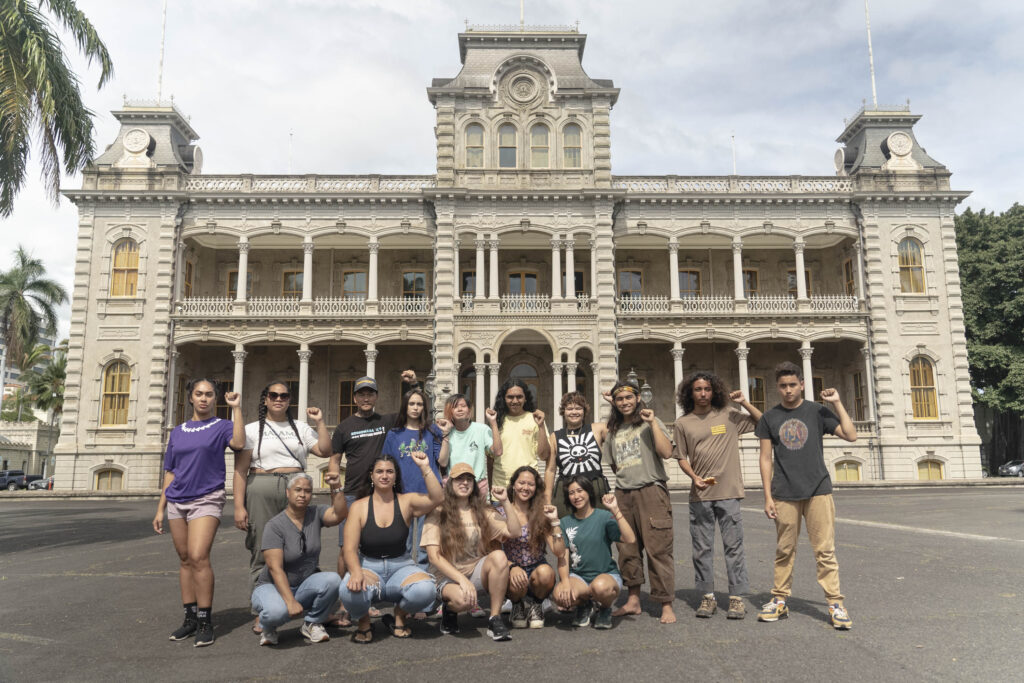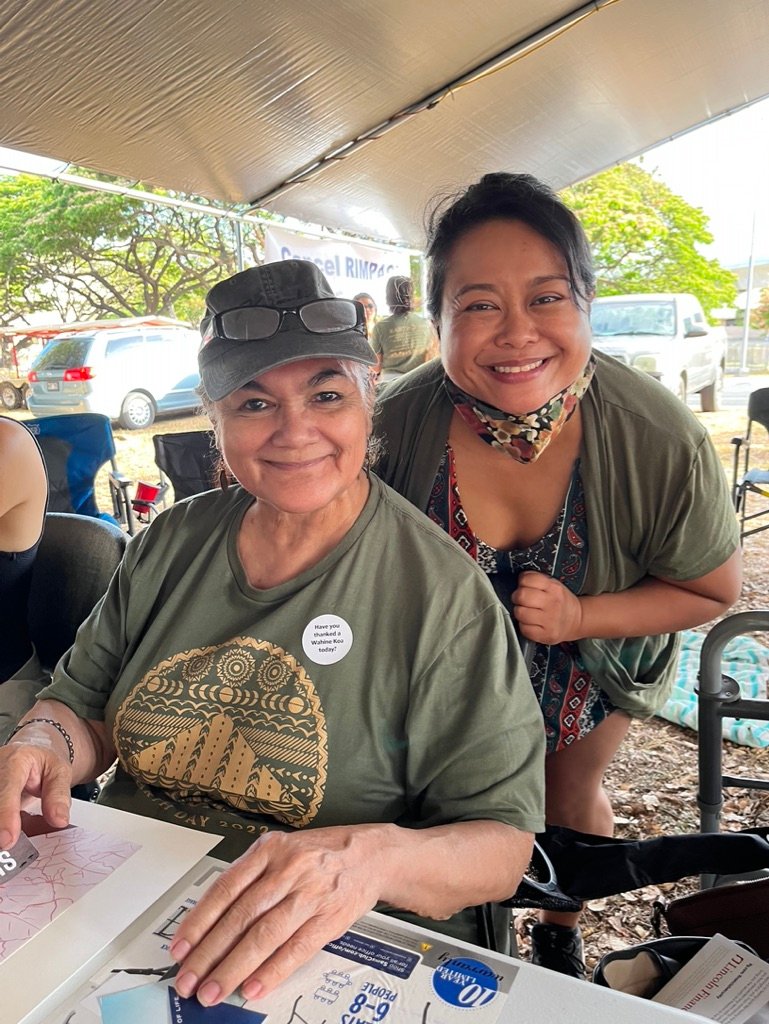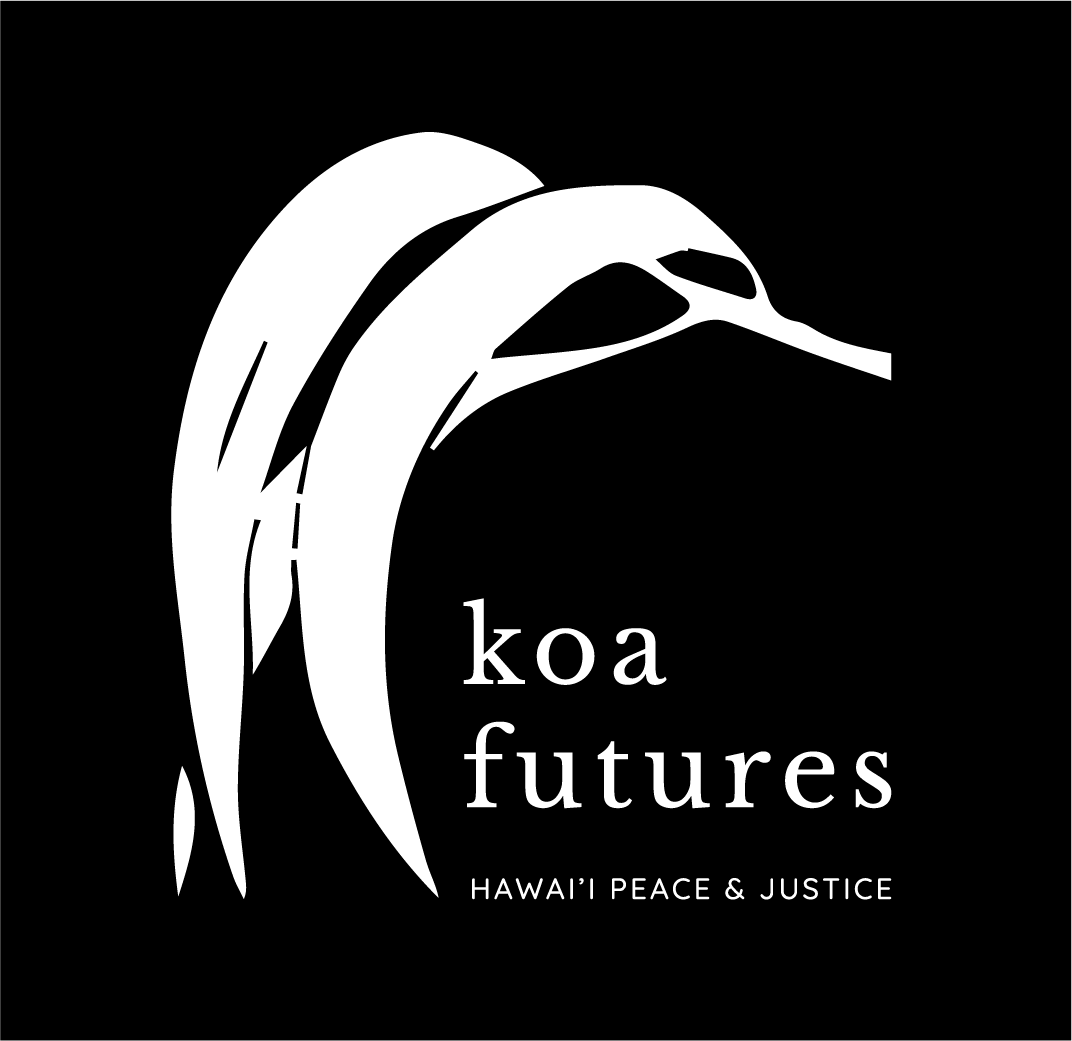
Youth Liberation Camp at Iolani Palace pc: Elorah Kwok
- 2022- 2023 HPJ hired two youth organizers and created a Youth Organizing Committee, Nā ʻŌpio Aloha ʻĀina, and in partnership with Hui Aloha ʻĀina o Honolulu, hosted our inaugural Youth Liberation camp. Youth from high schools from all around the island, as well as other youth participated in a three day camp to learn about the history of the overthrow and to discuss Hawaiian sovereignty, impacts of environmental racism, US imperialism and the military industrial complex. Students were given basic organizing 101 tools to begin organizing there own campaigns. Over the summer and fall youth are gaining both cultural and political education on key sites that are tied to the Army leases, to determine their position on the army lease renewals and other relevant issues impacting Hawaiʻi.
- 2021- 2022: HPJ board members and staff are key initiators in the Oʻahu Water Protectors movement Shutdown Red Hill campaign, in response the 27,000 gallon jet fuel leak from the US Navyʻs Red Hill Storage Tank Facility (Kāpukaki) that contaminates the fresh water supply of 93,000 residents. While the Department of Defense has declared that it will close the facility, the Navy is stating that the process may take up to two year
- 2020: HPJʻs Cancel RIMPAC coalition collects 12,000+ signatures to demand an end to RIMPAC exercises during the first year of COVID 19 epidemic. Community and international organizing efforts force the Navy to limit their exercises to at-sea only. This temporary reprieve to Hawaiʻi coastlines allowed for the return of turtle nesting where there is normally amphibious assaults and coastal devastation.
- 2017: HPJ supports an International Women Against Militarism delegation of Womenʻs Voices Women Speak solidarity trip to Okinawa
- 2012 -2013: HPJ develops youth outreach and political education programs in Waianae
- 2011: Hawaiʻi Peace and Justice officially launches as an independent non-profit, the successor of AFSC Hawaiʻi.
- 2005 – 2007: Our CHOICES counter-recruitment project won changes in the Hawai’i Department of Education to allow opt out procedures for the No Child Left Behind military recruitment list, which resulted in an increase in the number of students who requested to withhold their personal information from military recruiters from 1,913 in 2005/06 to 21,836 in 2006/07. We organized students and families to compel the Department of Education to prevent public schools from releasing test results and information of students who take the Armed Services Vocational Aptitude Battery test to military recruiters without their explicit informed prior consent.
- 2004: HPJ founding members Kyle Kajihiro and Terri Kekoʻolani begin conducting Detours which has educated over 1700+ students, activists, scholars, and community members about the environmental and social costs of the U.S. military occupation of Hawaiian lands and demilitarization struggles
- HPJ founding member Terri Kekoʻolani and fellow demil activists Ellen Rae-Cachola and Gigi Miranda form Womenʻs Voices Women Speak.(WVWS) WVWS was the first women’s delegation from Hawaiʻi to join the International Women’s Network Against Militarism in the Philippines.
- 2003: HPJ founding members help organize community opposition to Marine Corps jungle warfare training in Waikane valley, on lands of the Kamaka family. During World War II, the military leased Waikane lands for training and promised to return the land to its original condition. When the lands were returned to the Kamaka family, Raymond Kamaka began farming and working with youth. But the bombs kept turning up. Instead of cleaning up as promised, the Marines condemned the land over the objections of the family. When the Marines announced that they intended to return to Waikane Valley, the community came out in large numbers to demand an immediate cleanup of the valley and return of the lands to the Kamaka family. As a result, the Marines canceled their plans and began cleanup of the munitions.
- 2002: born out of the AFSC Rethinking Militarism in Hawaiʻi conference, DMZ Hawai’i / Aloha ‘Aina network is established, with its first issue to confront the military expansion in the wake of September 11, 2001. HPJ founding members became central organizers within the network, who developed various efforts to protest military expansion both throughout Hawaiʻi and abroad.
- 2000: American Friends Service Committee Demilitarization Subcommittee sponsors a conference “Rethinking Militarism in Hawai’i”. This is the first meeting to bring together activists and community leaders from various military-impacted communities to strategize and build a movement to address the impacts of militarization in Hawai’i.
- 1997: As staff of American Friends Service Committee Hawaiʻi, , HPJ founding members began The Hawai’i Gay Liberation Program’s work with the Hawaii Safe Schools Coalition begins new statewide anti-harassment policies that provided more safety for LGBTQ students to organize their own clubs on campus without fear of harassment or discrimination, and also connected youth to the movement for Hawaiian Sovereignty. Our Rainbow Revolutionaries youth project organized the first LGBTQ prom in Hawai’i, the first LGBTQ youth leadership retreat and the first Gay Straight Alliance Summit and has helped to develop a number of dynamic young leaders and activists.
- 1996: HPJ founding members begin working with Malama Makua to organize community support for the cleanup and return of Makua valley from the military. Due to a coordinated legal, political and Kanaka Maoli led cultural strategy, the Army has not used Makua for live fire training in more than seven years. The Army has stated that it has no plans to continue live fire training in Makua. Regular cultural access has allowed thousands to visit and participate in the healing of the land and Makahiki ceremonies have been restored. However, this is not enough. The campaign continues to not renew the Army leases and to return the lands to people of Hawaiʻi in perpetuity.
- 1993: HPJ founding members conduct a series of popular education workshops on Hawaiian Sovereignty. One outcome was the publication of the anthology He Alo A He Alo: Voices on Hawaiian Sovereignty and Resistance in Paradise.
- 1983: Founding members of HPJ, join the Nuclear Free and Independent Pacific Movement to call for an end to all nuclear testing in the Pacific, uranium mining and end to the Rim of the Pacific exercises (RIMPAC) that began in 1971. Hawaiʻi NFIP members are pivotal to asserting independence and self-determination become a central tenant to this movement
- 1976: Founding members of HPJ participated in the first boat expedition to protect the sacred island of Kahoʻolawe from U.S. Navy bombardments and began supporting the efforts of the Protect Kahoʻolawe ʻOhana to stop the bombing. As a result of Kanaka Maoli occupation and resistance, in 1990 President George H.W. Bush signed an executive order stopping the bombing and requiring the clean up of Kahoʻolawe. The island was transferred to the state of Hawaiʻi as a cultural reserve in trust until a Hawaiian nation is formed.

